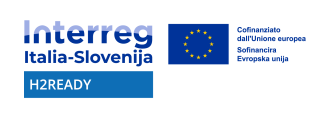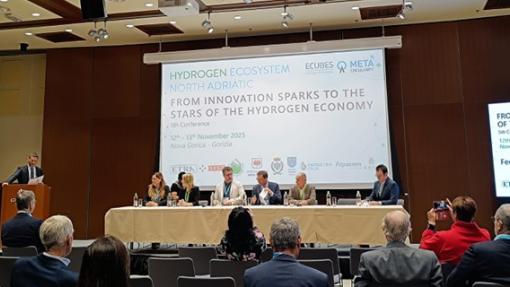The fifth edition of the Hydrogen Ecosystem North Adriatic Conference (Nova Gorica–Gorizia, 12–13 November 2025)
This year, the H2READY project had a strong presence—both among the audience and among the speakers—thanks to the active participation of several Project Partners, including GOLEA, the Municipality of Ajdovščina, CTS H2 S.R.L., and META Circularity, which also contributed to the organisation of the event.
A Strategic Dialogue on Hydrogen in the North Adriatic
The conference opened with remarks by Jurij Giacomelli, who underlined the symbolic and operational importance of hosting the event jointly in Gorizia and Nova Gorica, in a milestone year for the European Capital of Culture GO!2025.
He was followed by the Mayor of Nova Gorica, who recalled that “the future of hydrogen is already today”, emphasising how cities and local communities are already playing a decisive role within the hydrogen ecosystem.
The first day featured top-level European speakers presenting innovative models, pilot cases, and technological trends from the broader hydrogen ecosystem. Special attention was dedicated to the North Adriatic Hydrogen Valley (NAHV), the first European transnational initiative in this field, combining economic, energy, social, and innovation dimensions, made possible through the support of Horizon Europe.
The Presentation of the Ecosystem Report and the Progress of European Projects
During the second day, Stephen Taylor (Coordinator of the Joint Group) presented the new Ecosystem Report, highlighting:
the cross-border and multi-sectoral nature of NAHV,
the key role of EU funding, which must be complemented by consistent industrial investments,
opportunities for collaboration across the entire hydrogen value chain.
Several ongoing European projects were also presented, including:
NACHIP (i3 Programme), focused on technological development and pilots up to TRL9;
NASCHA (North Adriatic Smart Communities Hydrogen Accelerator), launched in November and aimed at building smart communities of practice, also supported by cascade funding mechanisms;
NAHV initiatives on hydrogen production and cross-border sharing, highlighting the Trieste hub, key challenges, and expected impacts.
H2READY as a Key Component of the Ecosystem
Among the projects presented, H2READY—represented by Project Coordinator Suzana Vidmar Kovšca (GOLEA)—stood out as an essential component of the North Adriatic ecosystem.
The presentation emphasised:
a specific focus on public procurement, a crucial yet complex lever for emerging technologies;
the challenge of a value-for-money procurement approach, which may disadvantage technologies still in development;
the need to strengthen awareness and institutional capacity among local authorities;
the central role of industry, municipalities, and universities as key stakeholders.
As highlighted by Jurij Giacomelli, H2READY is also helping to expand the geographical scope of cooperation to the Province of Venice, enlarging the reach of the North Adriatic Hydrogen Valley.
Institutional Capacity and New Horizons for Innovation
In the session dedicated to “Connecting EU Valleys and Hubs”, strong emphasis emerged on:
institutional capacity building, considered critical for accelerating implementation;
the integration of local communities and municipalities into the hydrogen ecosystem;
the need to develop shared data platforms and forecasting tools.
A particularly significant message came from the European Commission, which for the first time expressed strong political support for the NAHV initiative, recognising it as a strategic European action and calling on partners to accelerate implementation.
A Growing and Strengthening Ecosystem
The active presence of H2READY at the conference confirms the project’s role as an integrated component of the North Adriatic Hydrogen Valley, contributing to strengthening:
cross-border cooperation,
the development of skills and institutional capacity,
the adoption of hydrogen in public services,
the connection between technological innovation and local governance.
H2READY will continue to closely follow the evolution of NAHV and collaborate with i3 and Horizon Europe initiatives, strengthening the contribution of local communities to the energy transition in the North Adriatic area.

